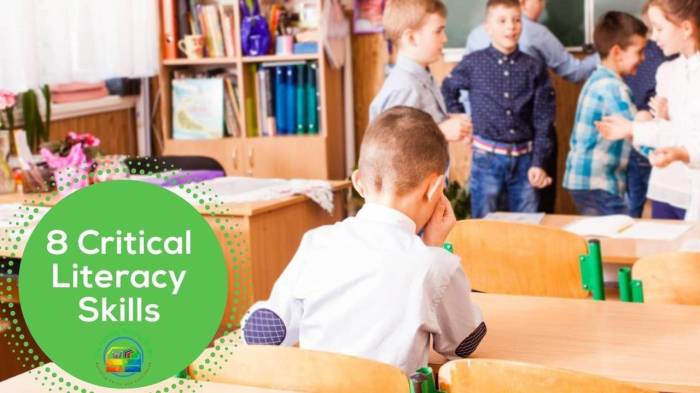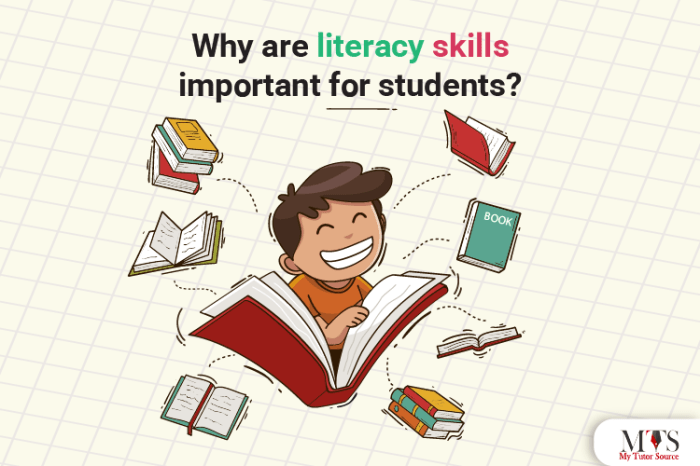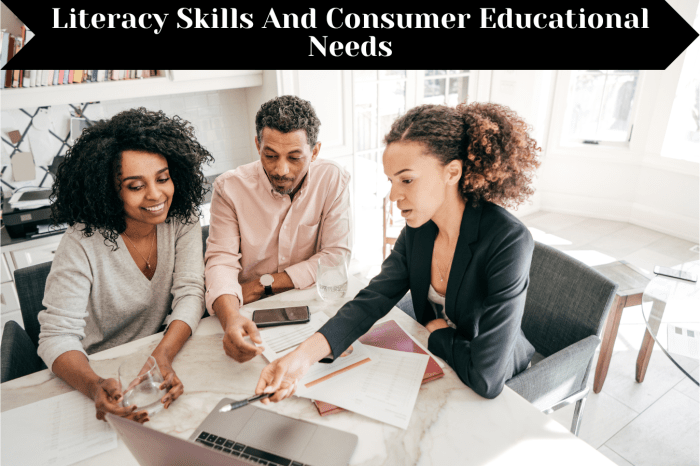Literacy skills and consumer educational needs are inextricably linked in the modern marketplace. Consumers with strong literacy skills are better equipped to navigate complex financial decisions, understand product labels, and protect themselves from fraud. This article explores the importance of literacy skills for consumers, the challenges faced by those with low literacy, and the role of consumer educational programs in improving literacy.
Literacy skills encompass a range of abilities, including reading, writing, numeracy, and problem-solving. These skills are essential for consumers to make informed decisions about products and services, manage their finances, and navigate the complexities of the marketplace.
Literacy Skills and Consumer Educational Needs

Literacy skills are essential for consumers to navigate the modern marketplace effectively. They empower individuals to make informed decisions, protect their rights, and manage their finances responsibly. However, many consumers face challenges with literacy, which can have significant implications for their well-being.
Consumers with low literacy skills may struggle to understand product labels, contracts, and financial statements. They may also have difficulty accessing and comprehending consumer information, which can lead to poor decision-making and financial losses. Furthermore, low literacy skills can hinder consumers’ ability to communicate effectively with businesses and service providers, making it difficult for them to resolve issues or advocate for their rights.
Literacy skills are a key component of consumer education, which aims to provide consumers with the knowledge and skills they need to make informed decisions and manage their finances effectively. Consumer educational programs can help individuals improve their literacy skills through various methods, such as:
- Providing basic literacy instruction
- Teaching functional literacy skills, such as reading and writing for everyday tasks
- Improving financial literacy, including budgeting, saving, and investing
- Developing digital literacy skills, such as using computers and the internet to access consumer information
By improving literacy skills, consumer educational programs can empower individuals to take control of their financial lives, make informed decisions, and protect their consumer rights.
Types of Literacy Skills: Literacy Skills And Consumer Educational Needs

There are several types of literacy skills relevant to consumer education, each with its own role in empowering consumers:
Functional Literacy
Functional literacy refers to the ability to read and write for everyday tasks, such as understanding product labels, filling out forms, and managing finances. This type of literacy is essential for consumers to navigate the marketplace and make informed decisions.
Financial Literacy, Literacy skills and consumer educational needs
Financial literacy encompasses the knowledge and skills necessary to manage personal finances effectively. It includes understanding concepts such as budgeting, saving, investing, and credit management. Financial literacy empowers consumers to make sound financial decisions and achieve their financial goals.
Digital Literacy
Digital literacy involves the ability to use computers and the internet to access and process information. In the modern marketplace, digital literacy is essential for consumers to access product reviews, compare prices, and make informed purchases online. It also allows consumers to communicate with businesses and service providers electronically.
Consumer Educational Programs

Consumer educational programs play a crucial role in improving literacy skills and empowering consumers. These programs can take various forms, including:
- Community-based programs:Offered by libraries, community centers, and non-profit organizations, these programs provide literacy instruction and financial education to individuals with low literacy skills.
- School-based programs:Integrated into school curricula, these programs aim to develop literacy skills and consumer knowledge among students.
- Workplace programs:Designed for employees, these programs provide financial education and digital literacy training to improve employees’ financial well-being and productivity.
Effective consumer educational programs typically use accessible language, engaging formats, and hands-on activities to make learning enjoyable and relevant. They also provide opportunities for participants to practice their skills and receive feedback.
Best Practices for Consumer Education
When designing and delivering consumer educational programs, it is essential to follow best practices to ensure their effectiveness:
- Use accessible language:Avoid jargon and technical terms. Use clear and concise language that is easy for all participants to understand.
- Engage participants:Incorporate interactive activities, role-playing, and real-world examples to make learning more engaging and memorable.
- Provide hands-on practice:Allow participants to practice their skills in a safe and supportive environment. This can include role-playing scenarios, completing financial worksheets, or using online resources.
- Use technology effectively:Leverage technology to enhance the learning experience. Use interactive online tools, videos, and simulations to make learning more accessible and engaging.
- Evaluate and improve:Regularly evaluate the effectiveness of consumer educational programs to identify areas for improvement and ensure that they are meeting the needs of participants.
Case Studies and Examples

Numerous successful consumer educational programs have demonstrated the positive impact of improving literacy skills:
- Jump$tart Coalition:A non-profit organization that provides financial literacy education to students and adults. Their programs have been shown to improve financial knowledge and skills, leading to better financial decision-making.
- National Financial Literacy Campaign:A public-private partnership that aims to improve financial literacy among Americans. Their programs have reached millions of people and have been shown to increase financial knowledge and reduce financial stress.
- Consumer Financial Protection Bureau (CFPB):A government agency that provides financial education resources and tools to consumers. Their website offers a wealth of information on various financial topics, including budgeting, saving, and investing.
These programs demonstrate the effectiveness of consumer educational initiatives in empowering individuals with the knowledge and skills they need to make informed financial decisions and improve their financial well-being.
Answers to Common Questions
What are the benefits of improving literacy skills for consumers?
Consumers with strong literacy skills are better able to understand product labels, make informed financial decisions, and protect themselves from fraud.
What are the challenges faced by consumers with low literacy skills?
Consumers with low literacy skills may struggle to understand complex financial information, navigate the healthcare system, and access essential services.
What are the different types of literacy skills relevant to consumer education?
Literacy skills relevant to consumer education include functional literacy, financial literacy, and digital literacy.
What is the role of consumer educational programs in improving literacy skills?
Consumer educational programs provide accessible and engaging learning opportunities to improve literacy skills, empowering consumers to make informed decisions.